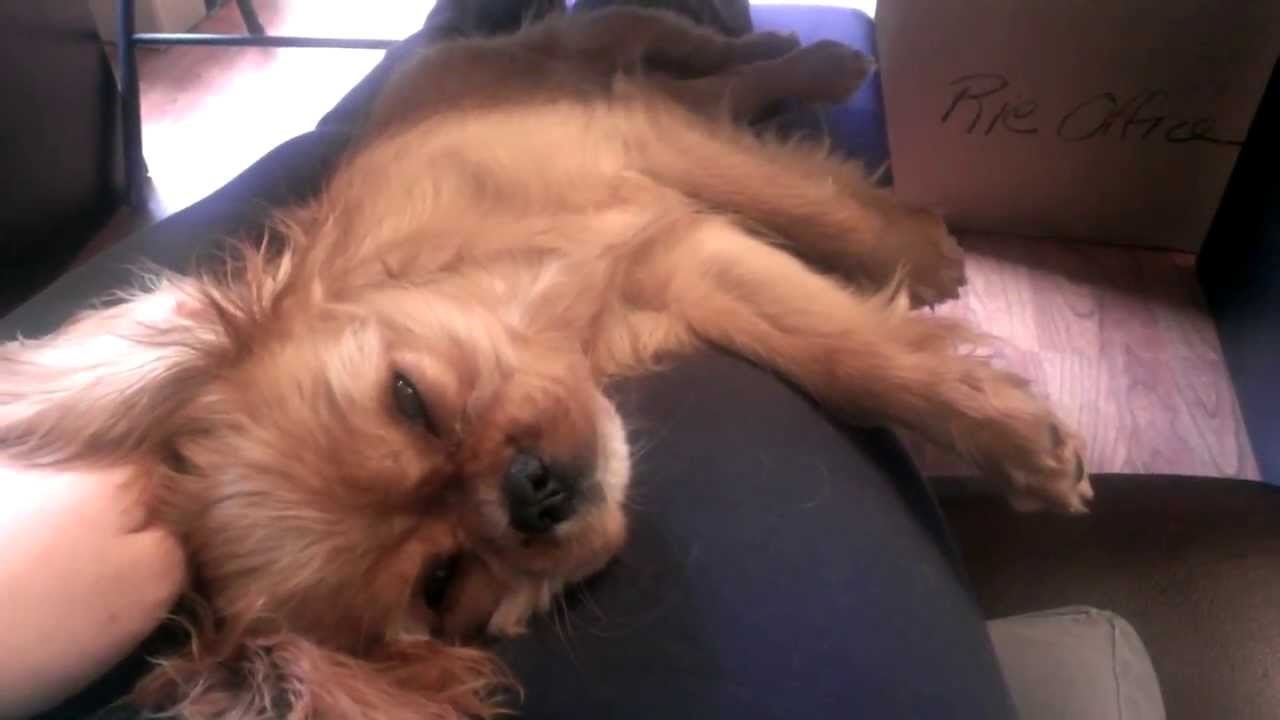
A ruby cavalier puppy lying on his master’s lap [1]
Bonding is necessary for normal development
The long-term discovery from Harlow’s work was that… isolated monkeys developed relatively normally physically, but abnormally socially. They did not interact with other monkeys well: terrified, they huddled in the corner when another young monkey was put into their cage.
Social interaction and personal contact is more than desirable: it is necessary for normal development.
Months later, Harlow tried to rehabilitate those monkeys whose early isolation so malformed them. He found that the best remedy was regular contact with young normal monkeys, whom he came to call “therapy monkeys,” in play. This restored some of the isolates to more normal social actors.
Petting dogs brings measurable changes that are very good
Simply petting a dog can reduce an overactive sympathetic nervous system within minutes: a racing heart, high blood pressure, the sweats. Levels of endorphins (hormones that make us feel good) and oxytocin and prolactin (those hormones involved in social attachment) go up when we’re with dogs. Cortisol (stress hormone) levels go down.
There is good reason to believe that living with a dog provides the social support which correlates with reduced risk for various diseases, from cardiovascular disease to diabetes to pneumonia, and better rates of recovery from those diseases we do get.
In many cases, the dog receives nearly the same effect. Human company can lower a dog’s cortisol level; petting can calm a racing heart.
Bonding with a pet can do the work that long-term use of prescribed drugs or cognitive behavioral therapy do.
Petting dogs is the first thing we reach for to build bonds
There are three essential behavioral means by which we maintain, and feel rewarded by, bonding with dogs. The first is contact: the touch of an animal…
Petting zoos have arisen to satisfy the urge to engage that animal on the other side of the fence not only by looking at it, but by touching it. Better still if the animal is touching back—with, say, a warm tongue or worn teeth grabbing at the food in your outstretched hands.
Children and even adults who approach me on the street as I walk with my dog want not to look at the dog, to watch her wag, to meditate on the dog—no, they want to pet the dog: to touch her. In fact, after a cursory rub, many people appear satisfied with that interaction. Even a brief touch is sufficient to bolster the feeling that a connection has been made.
Occasionally one might find one’s toes, hanging off the end of the bed bare, being licked.
Petting dogs — and in general, touch — is the first thing dogs reach for to build bonds
Dogs and humans share this innate drive for contact. … being held by the mother may be naturally comforting.
Watch an infant child, with limited vision and even more limited mobility, try to snuggle into his mother, his head rooting around for contact, and one is seeing just what newborn puppies look like.
Blind and deaf at birth, they are born with the instinct to huddle with siblings and their mother, or even with any solid object nearby. The ethologist Michael Fox describes the head of a puppy as a “thermotactile sensory probe,” moving in a semicircle until it touches something. This begins a life of social behavior reinforced by and embracing contact.
Wolves are estimated to make a move to touch one another at least six times an hour.
Petting dogs, and being touched by dogs, builds our bonds and maintains our bonds
Directed toward us, the dog’s youthful instinct becomes a drive to burrow a head under our sleeping bodies or to rest a head upon us; to push and bump us as we walk; to gently nibble or lick us dry. We find them touchable: furry and soft, right under dangling fingertips…
…full-body contact is preferred by some dogs, especially young dogs, and especially when they are the initiators of the contact. Dogs often find places to lie down that maximize contiguity of body with body. This might be a safe posture for dogs, especially as puppies, when they are entirely reliant on others for their care. To feel light pressure along the whole body is to have assurance of your well-being.
It is hard to imagine knowing a dog but not touching him—or being touched by him. To be nudged by a dog’s nose is a pleasure unmatched.[2]
- Tamaki, Rie. “Yuzu Ruby Cavalier King Charles Spaniel Puppy Sleeping on My Lap.” YouTube, 6 May 2013, youtube.com/watch?v=wtYrozATkP4. Accessed 28 May 2017.
- Horowitz, Alexandra. Inside of a dog: What dogs see, smell, and know. Scribner, 2009, Scribd pp. 325-343.